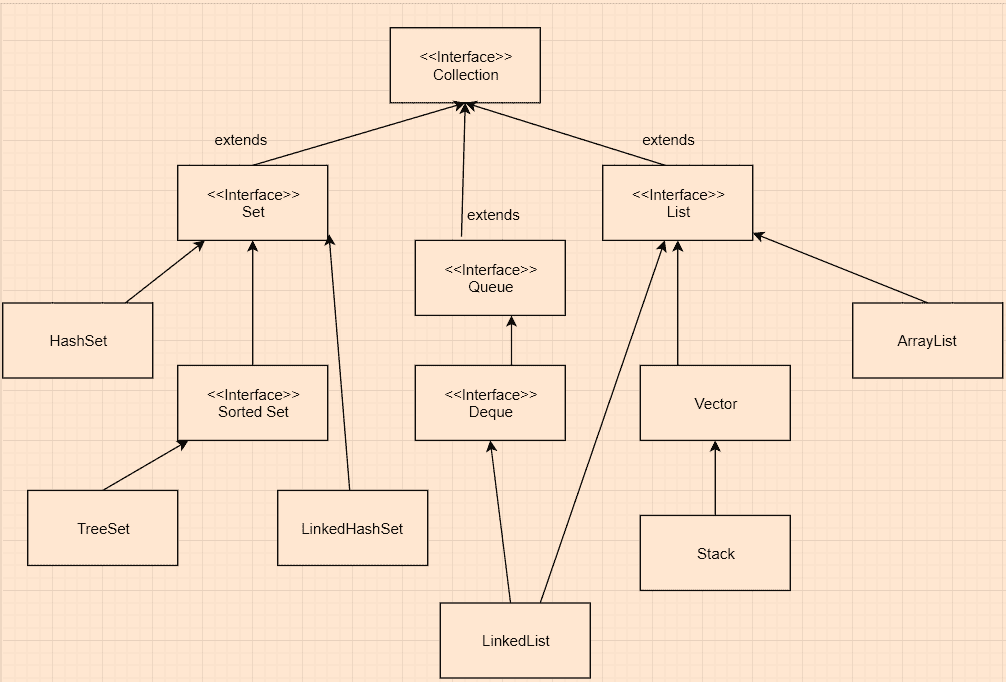# Java `LinkedHashMap`示例
> 原文: [https://javatutorial.net/java-linkedhashmap-example](https://javatutorial.net/java-linkedhashmap-example)
`LinkedHashMap`是哈希表和鏈表的組合,以可預測的迭代順序實現`Map`接口。[`HashMap`](https://javatutorial.net/java-hashmap-example)和`LinkedHashMap`之間的區別在于`LinkedHashMap`維護著一個雙向鏈表,該列表允許來回掃描所有條目。 順序保持不變,這意味著將鍵插入映射的順序。 如果將重新插入到映射中,則順序不會受到影響。`LinkedHashMap`提供所有可選的`Map`操作,還允許空元素。 就時間復雜度而言,就像[`HashMap`](https://javatutorial.net/java-hashmap-example)一樣,它為諸如`add`,`contains`和`remove`之類的基本操作提供了恒定時間的性能。`LinkedHashMap`有兩個影響其性能的參數,它們是初始容量和負載系數。 此類中的迭代不受容量的影響,因此在為初始容量選擇過高的值方面,它比`HashMap`效率更高。

## 為什么`LinkedHashMap`有用
1. 它將按照輸入到映射中的順序遍歷所有條目。
2. 就像在`HashMap`中一樣,允許使用空值。
3. 使用雙向鏈接的鏈表,使掃描效率更高。
4. 它對添加或訪問項目的順序有額外的了解。
## 繼承圖

繼承圖
## `LinkedHashMap`中的構造方法摘要
1. `LinkedHashMap()`:構造一個空的插入順序的 LinkedHashMap,其默認初始容量(16)和默認負載因子(0.75)。
2. `LinkedHashMap(int initialCapacity)`:構造一個空的插入順序的`LinkedHashMap`,并將容量設置為指定的 initialCapacity 參數和默認負載因子(0.75)。
3. `LinkedHashMap(int initialCapacity, float loadFactor)`:使用指定的容量和負載因子構造一個空的插入順序的`LinkedHashMap`。
4. `LinkedHashMap(int initialCapacity, float loadFactor, boolean accessOrder)`:使用指定的初始容量,負載系數和排序方式構造一個空的`LinkedHashMap`實例。
5. `LinkedHashMap(Map <? extends K, ? extends V> m)`:構造一個插入順序的`LinkedHashMap`實例,該實例具有與指定映射相同的映射。
## `LinkedHashMap`類中的方法
1. `void clear()`:從此映射中刪除所有映射。
2. `boolean containsValue(Object value)`:如果`LinkedHashMap`包含指定的值,則返回`true`,否則返回`false`。
3. `Set<Map.Entry<K,V>> entrySet()`:返回當前映射中包含的映射的設置視圖。
4. `V get(Object key)`:返回指定鍵所映射到的值;如果該映射不包含該鍵的映射,則返回`null`。
5. `V getOrDefault(Object key, V defaultValue)`:返回指定鍵所映射到的值;如果該映射不包含該鍵的映射,則返回`defaultValue`。
6. `Set<K> keySet`:返回此映射中包含的鍵的設置視圖。
7. `protected boolean removeEldestEntry(Map. Entry<K, V> eldest)`:返回此映射中包含的值的集合視圖。
8. `void put(K key, V value)`:將指定的`Value`與指定的`Key`相關聯。 (它是從 Java 中的`Map`類繼承的)
有關`EnumSet`主要方法的更多信息,請隨時訪問原始 [Oracle 文檔](https://docs.oracle.com/javase/8/docs/api/java/util/LinkedHashMap.html)。
### 獲取`LinkedHashMap`的大小,檢查其在特定鍵中是否包含某個值,并檢查其是否為空,最后從`LinkedHashMap`中刪除鍵:
```java
import java.util.*;
public class LinkedHashMapExample
{
public static void main(String args[])
{
LinkedHashMap<String, String> student =
new LinkedHashMap<String, String>();
student.put("name", "Joe");
student.put("major", "Computer Science");
student.put("marital status", "Single");
System.out.println(student);
// printing the value of the key called name
System.out.println("Key 'name's value: " + student.get("name"));
// getting the size of the linkedHashMap (size() is inherited from Map)
System.out.println("Size of the LinkedHashMap: " + student.size());
// checking whether the map is empty or not
System.out.println("Is the map empty: " + student.isEmpty());
// checking whether the linkedHashMap contains the key specified as an argument
System.out.println("Does it contain 'marital status'? "+ student.containsKey("marital status"));
// deleting/removing an element from the linkedHashMap works by using the
//remove method
System.out.println("Deleting element 'name': " + student.remove("name"));
}
}
```
**輸出**:
```java
{name=Joe, major=Computer Science, marital status = Single}
Key 'name's value: Joe
Size of the LinkedHashMap: 3
Is the map empty: false
Does it contain 'marital status'? true
Deleting element 'name': "Joe"
```
### 使用`clear()`清除`LinkedHashMap`
```java
import java.util.*;
public class LinkedHashMapExample {
public static void main(String[] args)
{
LinkedHashMap<String, String> student =
new LinkedHashMap<String, String>();
li_hash_map.put("name", "Joe");
li_hash_map.put("major", "Computer Science");
li_hash_map.put("marital status", "Single");
System.out.println("Current stage of linkedHashMap: " + student);
// Clearing the linked hash map using clear()
li_hash_map.clear();
System.out.println("Stage after the clear() method: " + student);
}
}
```
**輸出**:
```java
Current stage of linkedHashMap: {"name"="Joe", "major"="Computer Science", "marital status ="Single"}
Stage after the clear() method: {}
```
- JavaTutorialNetwork 中文系列教程
- Java 基礎
- Java 概述
- 在 Ubuntu 上安裝 Java 8 JDK
- Java Eclipse 教程
- Eclipse 快捷方式
- 簡單的 Java 示例
- Java 基本類型
- Java 循環
- Java 數組
- Java 讀取文件示例
- Java 對象和類教程
- 什么是面向對象編程(OOP)
- Java 封裝示例
- Java 接口示例
- Java 繼承示例
- Java 抽象示例
- Java 多態示例
- Java 中的方法重載與方法覆蓋
- Java 控制流語句
- Java 核心
- 如何在 Windows,Linux 和 Mac 上安裝 Maven
- 如何使用 Maven 配置文件
- 如何將自定義庫包含到 Maven 本地存儲庫中
- 如何使用 JUnit 進行單元測試
- 如何使用 Maven 運行 JUnit 測試
- 如何在 Java 中使用 Maven 創建子模塊
- 如何使用 Maven 創建 Java JAR 文件
- 如何使用 Maven 創建 Java WAR 文件
- JVM 解釋
- Java 內存模型解釋示例
- 捕獲 Java 堆轉儲的前 3 種方法
- Java 垃圾收集
- Java 互斥量示例
- Java 信號量示例
- Java 并行流示例
- Java 線程同步
- Java 線程池示例
- Java ThreadLocal示例
- Java 中的活鎖和死鎖
- Java Future示例
- Java equals()方法示例
- Java Lambda 表達式教程
- Java Optional示例
- Java 11 HTTP 客戶端示例
- Java 類加載器介紹
- Java 枚舉示例
- Java hashCode()方法示例
- 如何測試獨立的 Java 應用程序
- SWING JFrame基礎知識,如何創建JFrame
- Java SWING JFrame布局示例
- 在JFrame上顯示文本和圖形
- 與JFrame交互 – 按鈕,監聽器和文本區域
- 如何使用 Maven 創建 Java JAR 文件
- Java Collection新手指南
- 選擇合適的 Java 集合
- Java ArrayList示例
- Java LinkedList示例
- Java HashSet示例
- Java TreeSet示例
- Java LinkedHashSet示例
- Java EnumSet示例
- Java ConcurrentHashSet示例
- Java HashMap示例
- Java LinkedHashMap示例
- Java TreeMap示例
- Java EnumMap示例
- Java WeakHashMap示例
- Java IdentityHashMap示例
- Java SortedMap示例
- Java ConcurrentMap示例
- Java Hashtable示例
- Java 中ArrayList和LinkedList之間的區別
- Java HashMap迭代示例
- Java HashMap內聯初始化
- Java 中HashMap和TreeMap之間的區別
- Java 圖示例
- Java 深度優先搜索示例
- Java 廣度優先搜索示例
- 不同的算法時間復雜度
- Java 序列化示例
- Java 反射示例
- Java 中的弱引用
- Java 8 日期時間 API
- Java 基本正則表達式
- 使用 Java 檢索可用磁盤空間
- Java 生成 MD5 哈希和
- Java 增加內存
- Java 屬性文件示例
- 如何在 Eclipse 上安裝 Java 9 Beta
- Java 9 JShell 示例
- Java 9 不可變列表示例
- Java 9 不可變集示例
- Java 9 不可變映射示例
- Java 單例設計模式示例
- Java 代理設計模式示例
- Java 觀察者設計模式示例
- Java 工廠設計模式
- Java 構建器設計模式
- Java 比較器示例
- Java 發送電子郵件示例
- Java volatile示例
- Java Docker 和 Docker 容器簡介
- 安裝和配置 MySQL 數據庫和服務器以供 Spring 使用
- 如何在 Java 中使用 MySQL 連接器
- 如何使用 Eclipse 調試 Java
- Java EE
- 如何在 Windows 10 中設置JAVA_HOME
- JavaBeans 及其組件簡介
- 如何安裝和配置 Tomcat 8
- 如何在 Tomcat 中部署和取消部署應用程序
- 從 Eclipse 運行 Tomcat
- Java Servlet 示例
- Java Servlet POST 示例
- Servlet 請求信息示例
- Servlet 注解示例
- 使用初始化參數配置 Java Web 應用程序
- Java Servlet 文件上傳
- Java JSP 示例
- Glassfish 啟用安全管理
- 如何使用 MySQL 配置 Glassfish 4
- Java 文件上傳 REST 服務
- Glassfish 和 Jetty 的 Java WebSockets 教程
- 基于 Glassfish 表單的身份驗證示例
- 如何使用 Java EE 和 Angular 構建單頁應用程序
- Spring
- 在 Eclipse 中安裝 Spring STS
- 使用 STS 創建簡單的 Spring Web App
- Spring Web Framework 簡介
- Java Docker 和 Docker 容器簡介
- 在 Spring 中實現控制器
- Spring 中的PathVariable注解
- Spring 中的RequestBody注解
- Spring 中的RequestParam注解
- Spring 攔截器
- Spring IOC
- Java Spring IoC 容器示例
- Spring 中的DispatcherServlet
- Spring 示例中的依賴注入
- 實現 Spring MVC 控制器
- Spring ORM 簡介
- 什么是 DAO 以及如何使用它
- 如何對 DAO 組件進行單元測試
- 如何對控制器和服務執行單元測試
- 安裝和配置 MySQL 數據庫和服務器以供 Spring 使用
- 如何在 Spring 中處理登錄身份驗證
- Spring Security 簡介及其設置
- 如何使用 Spring 創建 RESTful Web 服務
- Spring CSRF 保護
- Spring 中基于 OAuth2 的身份驗證和授權
- Spring Boot 簡介
- Spring MVC 框架介紹
- Spring JDBC 簡介
- 如何 docker 化 Spring 應用程序
- Spring 的@Autowired注解
- Spring AOP 中的核心概念和建議類型
- Sping Bean 簡介
- 如何在 Java 中使用 MySQL 連接器
- 安卓
- 安裝和配置 Android Studio
- 將 Android 設備連接到 Android Studio
- Android 簡介,活動,意圖,服務,布局
- 創建一個簡單的 Android 應用
- 運行和調試 Android 應用程序
- 在虛擬設備上運行 Android 應用程序
- Android 活動示例
- Android 意圖示例
- Android 服務示例
- Android 線性布局示例
- Android 相對布局示例
- Android Web 視圖示例
- Android 列表視圖示例
- Android 網格視圖示例
- 帶有ListAdapter的 Android ListView示例
- Android SQLite 數據庫介紹
- Android SQLite 數據庫示例
- Android 動畫教程
- Android 中的通知
- Android 中的事件處理
- 如何在 Android 中發送帶有附件的電子郵件
- 雜項
- 選擇您的 JAVA IDE:Eclipse,NetBeans 和 IntelliJ IDEA
- Java S3 示例
- 如何在 Ubuntu 上為多個站點配置 Apache
- 如何在 Liferay DXP 中替代現成的(OOTB)模塊
- 簡單的 Git 教程
- 使用 Java 捕獲網絡數據包
- Selenium Java 教程
- 使用特定工作區運行 Eclipse
- 在 Eclipse 中安裝 SVN
- 如何運行 NodeJS 服務器
- SQL 內連接示例
- SQL 左連接示例
- SQL 右連接示例
- SQL 外連接示例
- 樹莓派
- Raspberry Pi 3 規格
- 將 Raspbian 安裝到 SD 卡
- Raspberry Pi 首次啟動
- 遠程連接到 Raspberry Pi
- 建立 Raspberry Pi 遠程桌面連接
- Raspberry Pi Java 教程
- 使用 PWM 的 Raspberry Pi LED 亮度調節
- Raspberry Pi 控制電機速度
- Raspberry Pi 用 Java 控制直流電機的速度和方向
